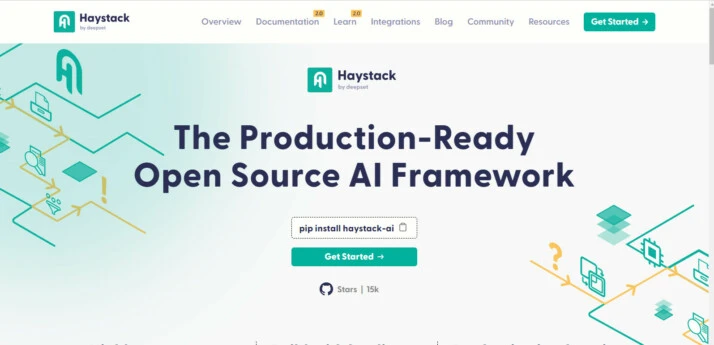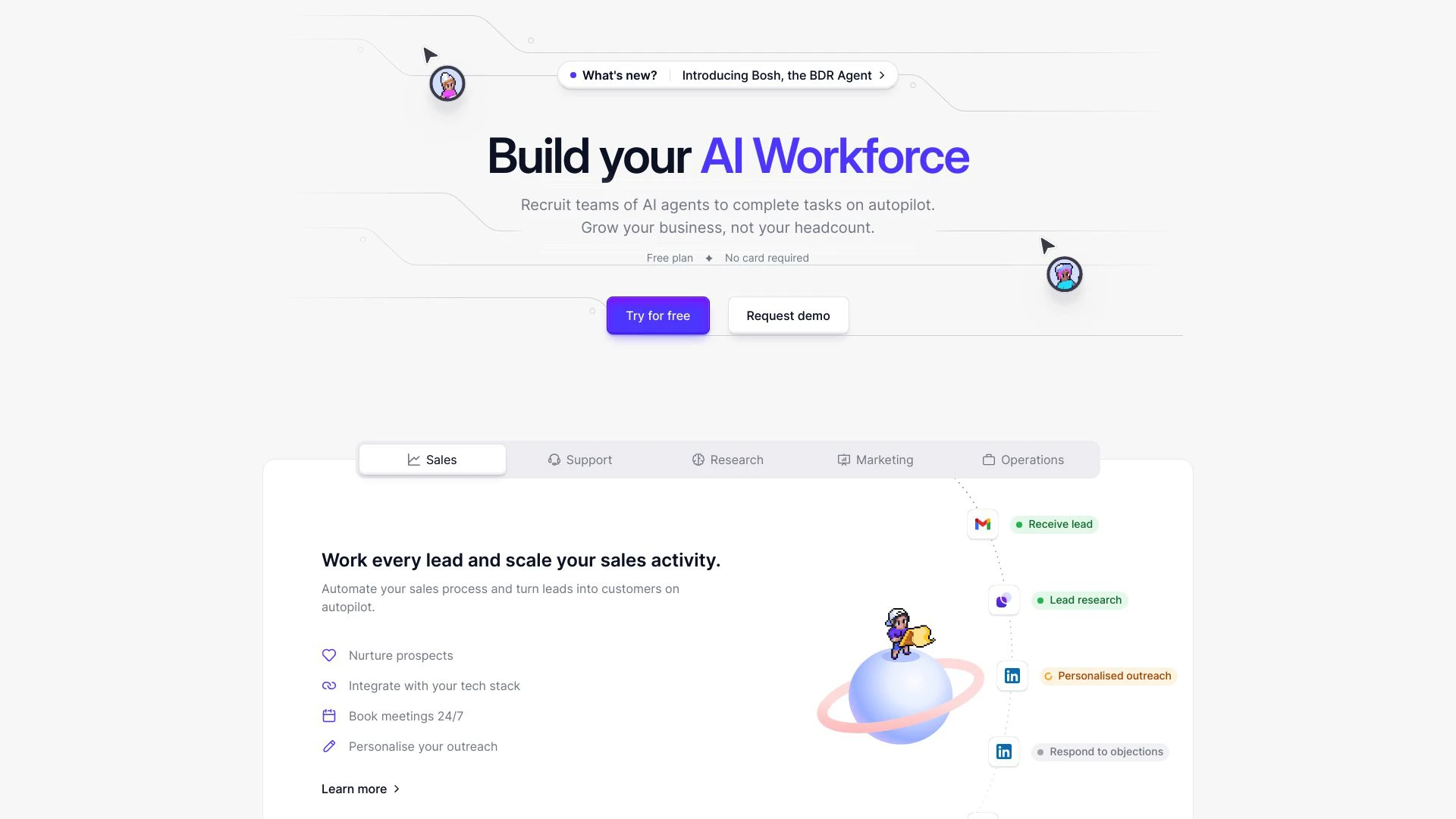Haystack vs. Relevance AI: Choosing Your AI Development Platform
AI-powered applications revolutionize industries, but choosing the right development platform can be challenging. This comparison explores Haystack, an open-source framework for custom NLP pipelines, and Relevance AI, a low-code platform for rapid AI agent creation. We’ll examine their strengths, limitations, and key features to help you make an informed decision. We’ll also introduce SmythOS, a comprehensive solution that combines flexibility, ease of use, and advanced capabilities. Whether you’re a developer seeking customization or a business leader looking for quick deployment, this guide will illuminate the strengths and trade-offs of each platform, empowering you to select the best tool for your AI development needs.
Haystack Overview
Haystack empowers developers to build intelligent applications using Large Language Models (LLMs) and vector search. This open-source framework excels in retrieval-augmented generation, question answering, and conversational AI tasks.


Haystack’s modular architecture allows developers to create custom pipelines by combining components like document stores, retrievers, and generators. This flexibility enables the construction of tailored solutions for diverse use cases, from chatbots to document search systems. The framework integrates seamlessly with popular AI tools and models, including Hugging Face Transformers, Elasticsearch, and OpenAI.
Haystack’s modular architecture allows developers to create custom pipelines by combining components like document stores, retrievers, and generators.
One of Haystack’s strengths lies in its ability to handle complex queries through AI agents. These agents can leverage various tools and models to break down and solve multi-step problems, making them well-suited for advanced natural language processing tasks. Haystack also supports multimodal retrieval, enabling applications to work with text, tables, and other content types.
While Haystack offers powerful capabilities, it requires some technical expertise to implement effectively. The framework lacks a visual builder or no-code editor, which may present a learning curve for non-technical users. However, for developers and data scientists, Haystack provides a robust platform for creating sophisticated AI-powered applications.
Haystack’s parent company, deepset, complements the open-source framework with deepset Cloud, a commercial platform that streamlines the development and deployment of NLP applications. This combination of open-source flexibility and enterprise-grade support positions Haystack as a versatile solution for organizations seeking to harness the power of AI in their products and services.
Relevance AI Overview
Relevance AI offers a low-code platform for building and deploying Large Language Model (LLM)-powered AI agents and tools. The platform empowers users to integrate advanced AI capabilities into their workflows without extensive programming skills.
Relevance AI prioritizes rapid development, allowing users to create custom AI agents and tools within minutes. The platform’s multi-provider support enables integration and switching between various LLM providers, ensuring flexibility as AI technologies evolve.
Relevance AI offers a low-code platform for building and deploying Large Language Model (LLM)-powered AI agents and tools… without extensive programming skills.


Key features include a built-in vector store for efficient text storage and retrieval, enhancing data handling capabilities. The platform’s ’Magic Deployment’ offers a fully managed service for deploying LLM features, eliminating infrastructure and scaling concerns. Relevance AI also provides a type-safe and flexible SDK for building applications with LLM features.
The platform caters to various use cases, offering customizable AI assistants that understand user input, learn from data, and perform tasks automatically. Ready-to-use templates for common tasks can be customized to fit specific needs, streamlining the development process. Relevance AI supports multiple data formats and provides robust data processing and storage capabilities.
While Relevance AI offers a comprehensive set of features, it may have limitations in areas such as advanced debugging tools or specialized deployment options. The platform’s focus on low-code development might not fully satisfy the needs of users requiring deep customization at the code level. Additionally, the extent of its multimodal capabilities and support for complex multi-agent collaborations is not explicitly clear from the available information.
Feature Comparison
Haystack and Relevance AI offer distinct approaches to building AI-powered applications, each with its own strengths and limitations. Haystack provides a flexible open-source framework for creating custom NLP pipelines, while Relevance AI focuses on a low-code platform for rapid AI agent development.
Haystack excels in its modular architecture, allowing developers to combine various components like document stores, retrievers, and generators. This flexibility enables the construction of tailored solutions for diverse use cases. However, Haystack lacks a visual builder or no-code editor, which may present a steeper learning curve for non-technical users. In contrast, Relevance AI’s low-code platform prioritizes rapid development, allowing users to create custom AI agents and tools within minutes, making it more accessible to a broader audience.
When it comes to core components and security, both platforms have notable gaps. Haystack offers robust support for AI agents, environments, and multimodal capabilities, but lacks features like a visual builder, no-code editor, and constrained alignment. Relevance AI, while providing a low-code environment and multi-provider support, does not explicitly mention advanced debugging tools or specialized deployment options. SmythOS addresses these limitations by offering a comprehensive suite of features, including a visual builder, no-code editor, and advanced security measures like constrained alignment and IP control.
Feature Comparison Table
| Haystack | Relevance AI | SmythOS | |
|---|---|---|---|
| CORE FEATURES | |||
| Visual Builder | ❌ | ✅ | ✅ |
| No-Code Options | ❌ | ✅ | ✅ |
| Explainability & Transparency | ✅ | ❌ | ✅ |
| Multi-Agent Collaboration | ✅ | ❌ | ✅ |
| Audit Logs for Analytics | ✅ | ❌ | ✅ |
| Work as Team | ✅ | ❌ | ✅ |
| Agent Work Scheduler | ❌ | ✅ | ✅ |
| SECURITY | |||
| Constrained Alignment | ❌ | ❌ | ✅ |
| IP Control | ❌ | ❌ | ✅ |
| COMPONENTS | |||
| Huggingface AIs | ✅ | ❌ | ✅ |
| Zapier APIs | ❌ | ❌ | ✅ |
| Data Lakes | ❌ | ❌ | ✅ |
| DEPLOYMENT OPTIONS (EMBODIMENTS) | |||
| Staging Domains | ❌ | ✅ | ✅ |
| Production Domains | ❌ | ✅ | ✅ |
| Deploy as Scheduled Agent | ❌ | ✅ | ✅ |
| DATA LAKE SUPPORT | |||
| Sitemap Crawler | ❌ | ❌ | ✅ |
| YouTube Transcript Crawler | ❌ | ✅ | ✅ |
| URL Crawler | ✅ | ❌ | ✅ |
Best Alternative to Haystack and Relevance AI
SmythOS emerges as the superior alternative to Haystack and Relevance AI, offering a comprehensive AI automation platform that addresses the limitations of both competitors. Our platform combines the best of both worlds: the flexibility of Haystack’s modular architecture and the rapid development capabilities of Relevance AI’s low-code environment.
We provide a powerful visual builder and no-code editor, making AI agent creation accessible to users of all skill levels. This feature set allows for rapid prototyping and deployment, significantly reducing the time and resources required to bring AI solutions to market.
SmythOS stands out with its robust deployment options and integrations. We support various AI models … and offer seamless integration with popular tools like Zapier.
Our platform excels in its extensive feature set, offering unparalleled versatility for a wide range of use cases. From autonomous agents and multi-agent collaboration to advanced debugging tools and explainable AI, SmythOS empowers users to create sophisticated AI systems with ease. We also prioritize security and compliance, implementing features like constrained alignment and IP control that are absent in both Haystack and Relevance AI.
SmythOS stands out with its robust deployment options and integrations. We support various AI models, including those from Hugging Face, and offer seamless integration with popular tools like Zapier. Our platform allows for deployment as APIs, webhooks, scheduled agents, and even GPTs, providing flexibility that surpasses both Haystack and Relevance AI. This versatility enables users to easily incorporate AI agents into existing workflows and systems, maximizing the value of their AI investments.
By choosing SmythOS, users gain access to a cutting-edge AI platform that combines ease of use, extensive capabilities, and enterprise-grade features. We empower organizations to harness the full potential of AI, driving innovation and efficiency across various industries and applications.
Conclusion
Haystack and Relevance AI offer powerful tools for building AI-powered applications, each with unique strengths. Haystack’s open-source framework provides flexibility for custom NLP pipelines, while Relevance AI’s low-code platform enables rapid AI agent development. However, SmythOS emerges as the superior choice, addressing limitations of both platforms.
SmythOS combines the best of both worlds, offering a visual builder and no-code editor for accessibility, alongside powerful features like hosted agents, multimodal capabilities, and advanced security measures. Our platform’s extensive integration ecosystem, with over 300,000 integrations, allows users to create complex workflows effortlessly.
Unlike Haystack and Relevance AI, SmythOS provides a comprehensive suite of deployment options. Our “Create Once, Deploy Anywhere” approach enables users to seamlessly integrate AI agents across various platforms and services. This versatility, combined with our robust debugging tools and scalable infrastructure, makes SmythOS ideal for businesses of all sizes.
Experience the future of AI development with SmythOS. Explore our diverse range of AI-powered agent templates to jumpstart your projects, or create a free account to build unlimited AI agents with no time limit. Unleash the full potential of AI for your business and join the SmythOS revolution today.
Last updated:
Disclaimer: The information presented in this article is for general informational purposes only and is provided as is. While we strive to keep the content up-to-date and accurate, we make no representations or warranties of any kind, express or implied, about the completeness, accuracy, reliability, suitability, or availability of the information contained in this article.
Any reliance you place on such information is strictly at your own risk. We reserve the right to make additions, deletions, or modifications to the contents of this article at any time without prior notice.
In no event will we be liable for any loss or damage including without limitation, indirect or consequential loss or damage, or any loss or damage whatsoever arising from loss of data, profits, or any other loss not specified herein arising out of, or in connection with, the use of this article.
Despite our best efforts, this article may contain oversights, errors, or omissions. If you notice any inaccuracies or have concerns about the content, please report them through our content feedback form. Your input helps us maintain the quality and reliability of our information.

